A step-by-step guide to planting shallots before winter
Shallots are a vitamin and tasty addition to the diet at any time of the year. If you want to surprise your family and guests, prepare Iranian sauce from shallots and natural yogurt. It will perfectly complement meat dishes - for example, barbecue.
It's easy to grow a shallot on your own, and it ripens earlier than a turnip. In this article, you will find detailed information on how to plant shallots before winter and get an early harvest.
The content of the article
Winter landing
Shallots, or family onions, are a nested variety of onions.... 6-12 daughter ones grow from one bulb.
Its heads are smaller (20-50 g), so they ripen faster. Family bow grown for greens or for a turnip.
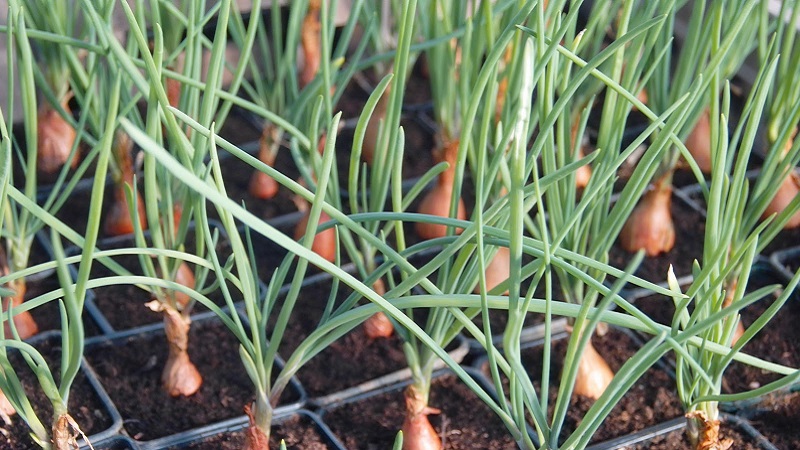
Is it possible to plant shallots before winter? Yes, you can. Planting in the fall allows you to harvest 2-3 weeks earlier and reduce the volume of spring gardening work. And the development of plants during the period of snow melting allows the rational use of moisture in the soil.
In addition, during podzimny planting, the heads grow 15-20% larger than the same varieties planted in spring.
Sowing dates
The optimal sowing time for family onions in the fall is determined based on the timing of soil freezing... From the moment of planting to freezing of the soil, 2-3 weeks should pass. During this time, the heads have time to take root, but do not grow.
Best predecessors
When planting onions in winter, do not forget about the rules crop rotation - crop rotation.
reference... The main rule of crop rotation is that one crop is not grown on the same bed for more than two years in a row.
Planting onions in the same place will lead to dominance of onion flies, chopping of bulbs and loss of crops... The culture is returned to its original place no earlier than after 4-5 years. The longer the break, the better.
After that, plant onions in the fall? For winter sowing, they choose the beds on which pumpkin seeds grew before (cucumbers, pumpkin, zucchini), tomatoes, legumes, cereals. It is not bad to sow after beets, mustard, rapeseed.
Do not plant onions after any of its other varieties, garlic, parsley, parsnips... Other unwanted precursors are potatoes, alfalfa, and red clover. Otherwise, there is a risk of nematode damage to the onion.
Varieties for autumn planting
Cold-resistant varieties are chosen for sowing in the fall., because the bulbs must have time to take root and not freeze out in winter.
Among the popular cold-resistant varieties are:
- Sire 7... A variety bred for cultivation in the northern regions. Differs in good keeping quality and average yield. Forms up to eight bulbs per nest.
- Sophocles... This variety is distinguished by large bulbs up to 50 g (7-9 pieces per nest). The taste is spicy. The color of the bulbs is red with a purple core. Undemanding to soil composition and high-yielding.
- Yellow Kuban... Suitable for southern regions. The variety is distinguished by a semi-sharp taste, quick ripening times and high productivity. Its keeping quality is high.
- Siberian amber... Not afraid of cold weather, resistant to disease. Medium-sized bulbs weighing 25-30 g (5-8 per nest). The taste is semi-sharp.
- Family... Resistant to cold snaps and diseases, ripens quickly. The average weight of the heads is 25 g. Up to five onions are formed in each nest. It has a mild taste.
Preparing for landing
Preparation for the autumn sowing of shallots consists in the choice of material for planting, its processing and preparation of the beds.
The choice of planting material
When sowing in winter, it is important to choose the right planting material.
Attention! Peduncle formation is influenced by the size of the bulb you plant. The larger it is, the higher the likelihood that the plant will shoot arrows.
Small heads, on the contrary, successfully overwinter and form lush green without arrows in the spring. A bulb weighing 10-15 g and 2 cm in diameter is the most preferred planting material.
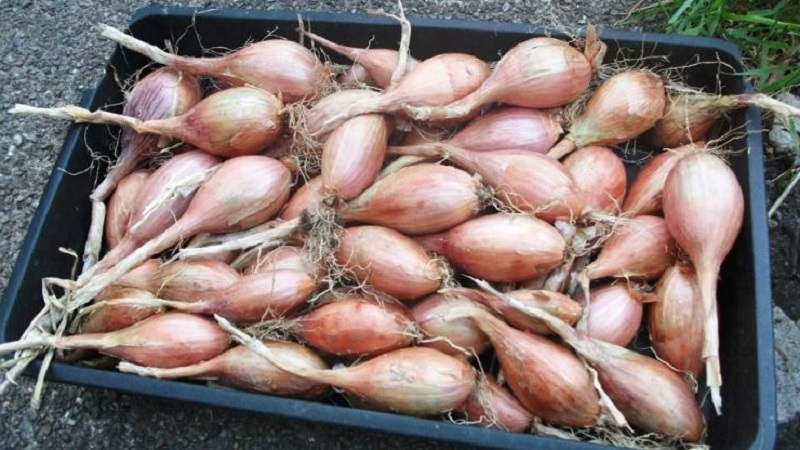
Shallots are propagated mainly vegetatively (by bulbs)... When sowing with seeds, the yield is lower and the ripening period is longer.
But when grown with bulbs after 3-5 years, shallots lose varietal qualities, accumulates disease and reduces yields. In this case, they sow with seeds or acquire new planting material from producers.
When sown with seeds, a bulb of five small heads grows in the first year... They are planted the next year. In the second year, a large nest with a large number of bulbs is formed. After that, the shallots are propagated vegetatively for 3-5 years.
Tillage
Sowing beds are made in a lighted area... The earth is dug up, cleared of weeds, fertilized and moistened. It is better to dig in advance so that the soil has time to settle.
From fertilizers, organic substances and mineral fertilizers are introduced: humus or compost (5-6 kg per 1 sq. m.), double superphosphate (60-80 g per 1 sq. m.), wood ash.
Moisten the soil before sowing... Then the plants will form a powerful root system and overwinter successfully.
Preparation of planting material
Before planting, the shallots are sorted and sorted... Instances with signs of disease, rot, mechanical damage are removed.
Selected bulbs are disinfected to prevent the development of diseases... For this, their soak in a solution of potassium permanganate or copper sulfate for 20-25 minutes.
Soaking in a solution of wood ash (250 g per 5 l of water) within 5-10 minutes will save the planting material from rot and nourish it with useful substances.
Winter landing technology
So, the seed was selected and prepared, the beds were dug up, fertilized and moistened. You can start sowing.
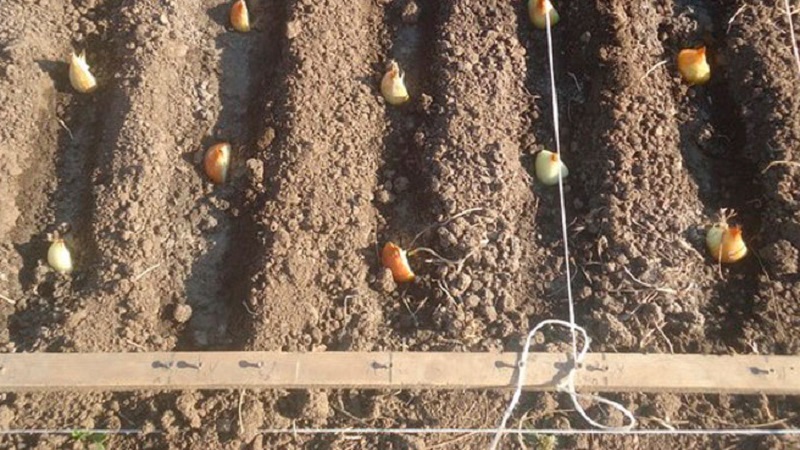
Step-by-step instruction
Act in this order:
- The ground on the surface of the bed is leveled and grooves are cut.
- Onions are laid out at the bottom of the grooves. The depth of the heads is about 4 cm. If the bulbs are larger than 3 cm in diameter, then 5-6 cm.
- The head is placed upside down. When planting shallots, the orientation of the bulb is important - if you plant it the other way around, the onion will not overwinter.
- After planting, the grooves are covered with moist soil and compacted.
- The surface of the garden bed is mulched and cover covering material.
In Siberia and the Urals, for better wintering, the beds are covered with spruce branches... Crops can withstand frosts down to -25 ° C without additional shelter, in more severe winters one cannot do without insulation.
Landing schemes
When sowing shallots, it is important to follow the planting patterns... A thickened crop will lead to the formation of small bulbs, since there is neither space nor nutrients for a large nest.
The grooves are cut at a distance of 35-45 cm from each other... In the row between the heads, 8-10 cm are left.
Common mistakes
Novice gardeners make when sowing family onions in autumn, such mistakes:
- bulbs with signs of disease are used for sowing, damaged heads - such material will not give a high-quality crop even with proper care;
- shallots are planted from their own seed for more than 3-4 years - over time, the onion degenerates and it is necessary to grow new seed from seeds;
- thicken crops - shallot nests need much more space for growth and development than onions;
- large heads (more than 2 cm in diameter) are chosen for planting - such specimens are more likely to shoot and winter worse than small ones.
Planting care
Winter shallot care is practically the same from care of spring plantings.
In the spring, the beds need to be opened after the snow melts., because greens appear quickly. The soil is periodically loosened and weeds removed. Considering that during the growth period the plants actively use spring moisture, the need for watering practically disappears.
If the soil was fertilized in the fall, then the autumn shallot will not need additional fertilizing.... Otherwise, after the regrowth of 3-4 leaves, nitrogen fertilizers are applied (slurry, urea), and at the beginning of the formation of bulbs, potash or ash is added.
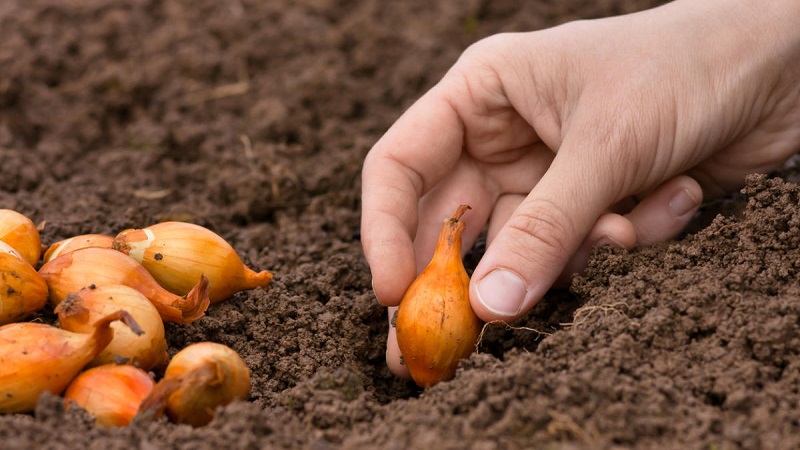
Diseases and pests
If spring is damp and cold, then planting can be affected by downy mildew and cervical rot. Affected plants are removed, the rest are treated with special antifungal drugs.
Attention! After being treated with chemicals, the green feather is not suitable for human consumption. If you grow onions for herbs, then use only safe folk remedies
Of the pests for onions is especially dangerous onion fly... To deal with it helps sprinkle the beds with ash and watering with a solution of table salt (1 tbsp. Per 10 liters of water).
Features of cultivation depending on the region
When determining the specific dates for planting shallots, they are guided by the weather conditions of the growing region.
The time is chosen so that the onion has time to take root, but does not begin to grow... This means that sowing is carried out 2-3 weeks before the arrival of frost.
Need to know. Often, the plantings of shallots freeze out not because of severe frosts, but because the bulbs did not have time to take root.
In Siberia and the Urals, the optimal timing of autumn sowing of family onions - the period from late September to early October. In the Moscow Region and the Leningrad Region - until mid-October. In the Krasnodar Territory, they sow until the beginning of November.
Tips from experienced summer residents
Experienced gardeners advise growing shallots on a green feather... Shallot feathers do not coarsen over time and retain their taste and nutritional properties. Therefore, it is often grown for commercial greens.
Important! Shallots are the most cost-effective green onion.
Shallot leaves are cut at a height of 20-25 cm, one month after planting... Such early maturity is another advantage of shallots over onions.
Growing shallots for turnips also deserves attention.... In addition to the earlier harvest, shallots are better stored in the winter. Its heads are denser, and their small size is convenient to use.
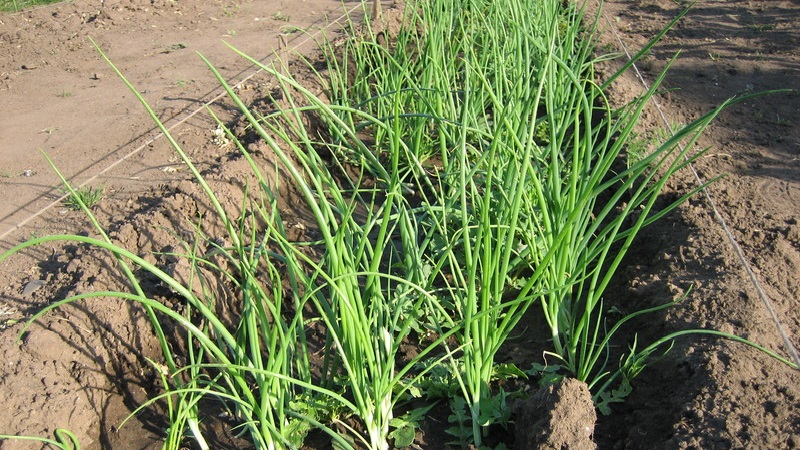
It is recommended to sow family onions in two separate beds.: for planting material and for food. Large bulbs are planted on the seed - they make a nest of small ones, convenient for planting next year. And on the second bed, small onions are sown, from which large heads grow.
Shallots are planted on fertilized with humus and mineral fertilizers of the soil.
Council. If you pluck a couple of heads from the nest during growth, then the rest of the bulbs will grow more weighty.
Conclusion
Planting shallots before winter deserves attention, as it allows you to get early greens and bulbs. In addition, the small shallots are easy to store and easy to use.
When planting before winter, it is important to choose the right place for the garden, taking into account the predecessors, use high-quality seed and follow the planting patterns. And when grown in the Urals and Siberia - to additionally insulate the crops for better wintering.